
Spain is facing its worst drought in over a hundred years, with water reserves at their lowest level even before the start of summer. This situation, in the spotlight in 2023, has worsened year-on-year due to climatic conditions and the way water resources are managed. In April, the highest temperature ever recorded in Europe this early in the year was reached on April 27 in Cordoba in southern Spain at 38.8 ˚ C, and across the country as a whole, temperatures were between +10 and +18 ˚ C above the seasonal average.
This heatwave added to an already very tense situation due to a drought present throughout the country and numerous fires starting early for the season. A state of drought was declared as early as March, and three-quarters of the country is affected by extreme drought, the highest level. Desertification threatens around 74% of the country, and varies from region to region, with 18% of the country at high or very high risk, including Andalusia and Catalonia.

This trend now seems inevitable, and is mainly due to man-made factors: global warming, which is causing changes in atmospheric circulation, on the one hand, and water management problems, on the other. Over the last ten years or so, Western Europe, particularly Spain, Portugal, France and England, has been increasingly confronted with long, intense anticyclonic blockages.
This phenomenon, known as the anticyclonic dome or heat dome, is due to subtropical anticyclones which are increasingly moving northwards, where they stagnate for longer and are at the same time more powerful. The anticyclone, accompanied by calm, precipitation-free weather, will trigger or aggravate the drought.
This change in weather conditions is set to worsen in the coming years as global warming continues, as it is not a small phenomenon like some weather phenomena. Weather forecasts for Spain, for example, predict 25% less precipitation over the next fifty years, and heat that will encourage evaporation of the little water that falls to the ground. But a reduction in greenhouse gas emissions could slow the desertification process that Spain is beginning to experience, as it is directly linked to the consequences of global warming.

According to Salvador Sanchez-Carillo, a Spanish geologist and researcher at the Higher Council for Scientific Research and the National Museum of Natural Sciences, interviewed by Globe Echo magazine, desertification is exacerbated by the country’s very poor water management. The researcher explains that if water management doesn’t change, the country will become a desert, and not within a hundred years, but within a decade.
The scientist points out that when the country began to develop in the 1960s, groundwater was exploited and then over-exploited, mainly for the irrigation of certain higher-yielding crops. As a result, aquifer levels have fallen, and in the event of drought, the ecosystems that need groundwater to survive have none left. In Spain, 25% of groundwater reserves are over-exploited, 46% are in critical or poor condition, and in the south of the country, water reservoirs are only 7 to 25% full, even though summer has not yet begun. In 2022, Spain introduced a new strategy to combat desertification in the form of an ecological monitoring and development program scheduled to last until 2030, with the aim of restoring soil degraded by erosion.




